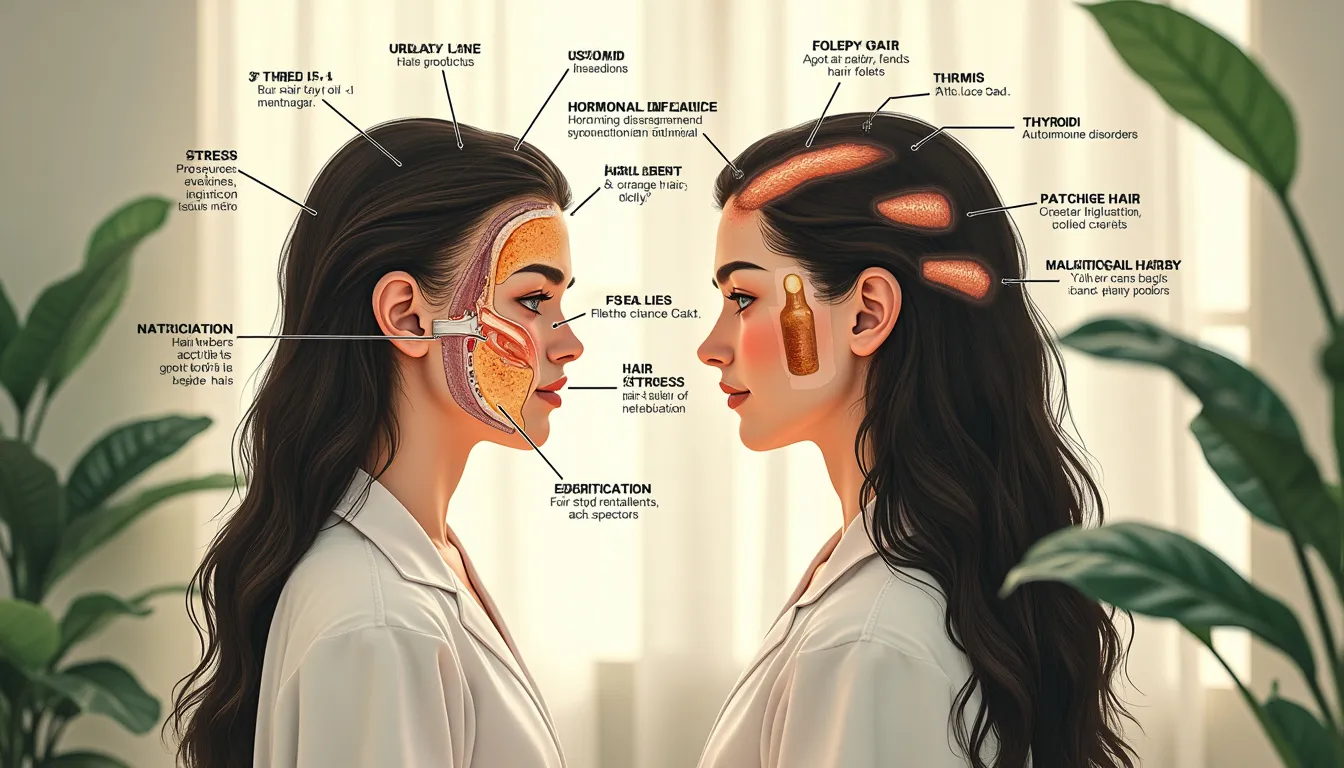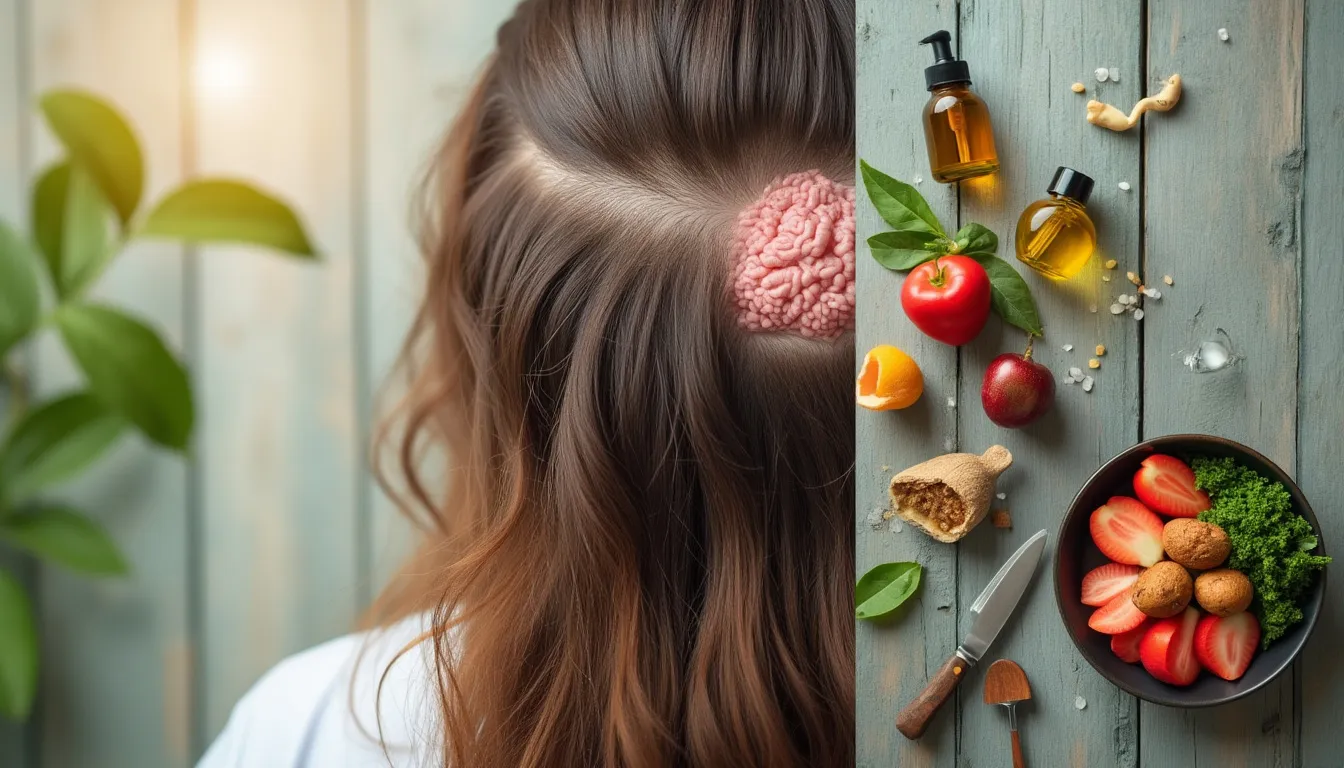Are you noticing more hair in your brush or shower drain lately? You’re not alone. Hair loss is a common concern that affects millions of people worldwide, regardless of age or gender. While it’s normal to shed 50-100 strands a day, excessive hair loss can be distressing and impact your self-esteem. Understanding the root causes of hair loss is the first step towards finding effective solutions and regaining your confidence. In this comprehensive guide, we’ll explore the most common causes of hair loss, from genetic factors to lifestyle choices, and everything in between. Whether you’re dealing with a receding hairline, thinning patches, or overall hair thinning, we’ll help you uncover the potential reasons behind your shedding. By the end of this article, you’ll have a better understanding of what might be causing your hair loss and be equipped with knowledge to take action. So, let’s dive into the world of hair loss causes and start your journey towards healthier, fuller hair.
Common Types of Hair Loss
When it comes to understanding hair loss, it’s essential to recognize that not all shedding is created equal. In fact, there are several common types of hair loss, each with its own unique characteristics and causes. Let’s dive into the three most prevalent forms of hair loss that might be behind your thinning locks.
Androgenetic Alopecia: The Most Common Culprit
If you’re noticing a gradual thinning of your hair, especially on the top of your head or around your hairline, you might be dealing with androgenetic alopecia. This condition, also known as male or female pattern baldness, is the most common cause of hair loss worldwide.
Androgenetic alopecia affects both men and women, though it manifests differently in each:
- In men: Hair loss typically begins at the temples or crown, often progressing to partial or complete baldness.
- In women: Thinning usually occurs all over the scalp, with the most noticeable loss along the part line.
The primary culprit behind this type of hair loss is genetics, combined with the presence of male hormones called androgens. These hormones can shrink hair follicles over time, leading to progressively thinner and shorter hair until the follicles stop producing hair altogether.
While androgenetic alopecia isn’t harmful to your health, it can certainly take a toll on your self-esteem. The good news? There are various treatments available, from over-the-counter options like minoxidil to prescription medications like finasteride. Some people even opt for hair transplant surgery for a more permanent solution.
Telogen Effluvium: When Stress Takes Its Toll
Have you ever noticed more hair than usual clogging your shower drain after a particularly stressful period in your life? You might be experiencing telogen effluvium, a temporary form of hair loss triggered by physical or emotional stress.
Unlike androgenetic alopecia, which affects specific areas of the scalp, telogen effluvium causes thinning all over the head. It occurs when a significant number of hair follicles enter the telogen (resting) phase of the hair growth cycle simultaneously, leading to increased shedding.
Common triggers for telogen effluvium include:
- Major surgery or severe illness
- Significant weight loss
- Childbirth
- Intense emotional stress (like the loss of a loved one)
- Certain medications
The good news about telogen effluvium is that it’s usually temporary. Once the underlying stressor is addressed, hair typically grows back within 6 to 9 months. However, if you’re experiencing prolonged or severe hair loss, it’s always a good idea to consult with a healthcare professional to rule out any underlying health issues.
Alopecia Areata: When Your Immune System Turns Against Your Hair
Imagine waking up one day to find a small, round, completely bald patch on your scalp. This scenario is all too real for people with alopecia areata, an autoimmune disorder that causes the body’s immune system to attack hair follicles.
Alopecia areata can manifest in several ways:
- Patchy alopecia areata: The most common form, characterized by coin-sized patches of hair loss on the scalp or other parts of the body.
- Alopecia totalis: Complete hair loss on the scalp.
- Alopecia universalis: Loss of all body hair, including eyebrows and eyelashes.
While the exact cause of alopecia areata isn’t fully understood, it’s believed to be triggered by a combination of genetic and environmental factors. Stress, viral infections, and other autoimmune conditions may play a role in its development.
Treatment for alopecia areata can be challenging, as the condition can be unpredictable. Some people experience spontaneous regrowth, while others may have persistent hair loss. Treatment options range from topical and injectable corticosteroids to immunotherapy and even JAK inhibitors in severe cases.
Living with alopecia areata can be emotionally challenging, but support groups and counseling can help individuals cope with the psychological impact of this condition.
The Importance of Early Intervention
Regardless of the type of hair loss you’re experiencing, early intervention is key. The sooner you address the issue, the better your chances of slowing or even reversing hair loss. If you’re noticing increased shedding or thinning, don’t hesitate to reach out to a dermatologist or trichologist for a proper diagnosis and treatment plan.
Remember, while hair loss can be distressing, you’re not alone in this journey. Millions of people worldwide deal with hair loss, and there are more treatment options available today than ever before. From medical interventions to cutting-edge hair loss prevention programs like Fortify, there’s hope for those looking to maintain their luscious locks.
Understanding the type of hair loss you’re dealing with is the first step towards finding an effective solution. By identifying the underlying cause, you can work with healthcare professionals to develop a tailored approach to address your specific hair loss concerns. Remember, your hair may be thinning, but your options for tackling it are only growing!

Medical Conditions That Contribute to Hair Loss
While genetics and lifestyle factors play a significant role in hair loss, various medical conditions can also lead to thinning locks and bald patches. Understanding these underlying health issues is crucial for proper diagnosis and treatment. Let’s dive into some of the most common medical conditions that contribute to hair loss.
A. Thyroid Disorders
The thyroid gland, that butterfly-shaped organ in your neck, plays a vital role in regulating metabolism and other bodily functions. When it goes haywire, your hair can suffer the consequences.
Hypothyroidism: This condition occurs when your thyroid gland doesn’t produce enough hormones. Symptoms often include:
- Fatigue
- Weight gain
- Dry skin
- And yes, you guessed it – hair loss
The lack of thyroid hormones can disrupt the hair growth cycle, leading to premature shedding and slower regrowth.
Hyperthyroidism: On the flip side, when your thyroid goes into overdrive, producing too many hormones, it can also cause hair loss. This condition may lead to:
- Rapid heart rate
- Unexplained weight loss
- Anxiety
- Thinning hair all over the scalp
The good news? Once thyroid function is restored through medication or other treatments, hair growth often returns to normal. However, patience is key, as it may take several months to see improvement.
B. Autoimmune Diseases
Sometimes, our immune system gets a little confused and starts attacking our own body. When this happens, hair loss can be an unfortunate side effect. Let’s look at some autoimmune conditions that can lead to hair loss:
1. Alopecia Areata
This condition deserves a special mention as it’s an autoimmune disorder specifically targeting hair follicles. Alopecia areata can cause:
- Sudden hair loss in circular patches
- Complete loss of scalp hair (alopecia totalis)
- Loss of all body hair (alopecia universalis)
While the exact cause is unknown, stress and genetics are believed to play a role. Treatment options include corticosteroids, topical immunotherapy, and in some cases, simply waiting it out as hair may regrow on its own.
2. Lupus
Systemic lupus erythematosus (SLE) is a complex autoimmune disease that can affect various parts of the body, including the skin and hair follicles. Hair loss in lupus patients may appear as:
- Overall thinning
- Bald patches
- Hair breakage, especially around the hairline (giving a lupus hair appearance)
Managing lupus symptoms through medication and lifestyle changes can help reduce hair loss associated with the condition.
3. Psoriasis
While psoriasis is primarily known for causing red, scaly patches on the skin, it can also affect the scalp and lead to hair loss. Scalp psoriasis may cause:
- Itching and burning sensations
- Temporary hair loss due to scratching and inflammation
- In severe cases, scarring that can lead to permanent hair loss
Treating scalp psoriasis with medicated shampoos, topical treatments, or systemic medications can help manage symptoms and reduce hair loss.
C. Nutritional Deficiencies
You are what you eat, and your hair is no exception! Nutritional deficiencies can significantly impact hair health and growth. Let’s explore some key nutrients that, when lacking, can lead to hair loss:
1. Iron Deficiency
Iron plays a crucial role in producing hemoglobin, which carries oxygen to cells throughout your body, including hair follicles. When iron levels are low, it can lead to:
- Fatigue
- Pale skin
- Brittle nails
- Hair loss or thinning
Iron deficiency is particularly common in menstruating women, vegetarians, and vegans. Incorporating iron-rich foods like lean meats, leafy greens, and legumes into your diet can help. In some cases, iron supplements may be necessary, but always consult with a healthcare provider before starting any supplementation.
2. Vitamin D Deficiency
The sunshine vitamin does more than just support bone health. Vitamin D also plays a role in hair follicle cycling and hair growth. A deficiency may contribute to:
- Hair thinning
- Slower hair growth
- Increased hair shedding
While sunlight is the best source of vitamin D, dietary sources include fatty fish, egg yolks, and fortified foods. For those living in less sunny climates or with limited sun exposure, vitamin D supplements may be beneficial.
3. Zinc Deficiency
Zinc is an essential mineral that supports protein synthesis and cell division – both crucial for healthy hair growth. A lack of zinc can lead to:
- Hair loss
- Slow wound healing
- Weakened immune system
Good sources of zinc include oysters, beef, pumpkin seeds, and lentils. While zinc supplements are available, it’s important not to overdo it, as excessive zinc can interfere with other nutrient absorption.
4. Biotin (Vitamin B7) Deficiency
Biotin, also known as vitamin B7, is often touted as a hair growth supplement. While true biotin deficiency is rare, when it does occur, it can cause:
- Hair thinning
- Brittle nails
- Skin rashes
Biotin can be found in foods like eggs, nuts, seeds, and sweet potatoes. While biotin supplements are popular, there’s limited scientific evidence supporting their effectiveness in promoting hair growth in those without a deficiency.
Understanding the medical conditions that contribute to hair loss is crucial for addressing the root cause of your thinning locks. If you’re experiencing unexplained hair loss, it’s essential to consult with a healthcare provider to rule out these underlying issues. Remember, healthy hair starts from within, so taking care of your overall health is key to maintaining a luscious mane.
While addressing medical conditions is important, it’s also crucial to protect your hair from further damage. Consider exploring hair care solutions like Fortify, which can help strengthen and protect your hair while you work on addressing any underlying health issues.

III. Lifestyle factors and external causes of hair loss
While genetics and medical conditions play a significant role in hair loss, our daily habits and external factors can also contribute to thinning locks. Let’s dive into some of the lifestyle factors and external causes that might be sneakily sabotaging your luscious mane.
A. Stress and emotional trauma
We’ve all heard the phrase I’m so stressed, I’m pulling my hair out! But did you know that stress can actually cause your hair to fall out on its own? It’s true! Stress is one of the most common hair loss causes that often goes overlooked.
When you’re under significant stress, your body enters a fight or flight mode, redirecting resources to essential functions. Unfortunately, hair growth isn’t considered a priority in survival situations. This can lead to a condition called telogen effluvium, where hair follicles prematurely enter the resting phase and fall out.
Some stress-related factors that can contribute to hair loss include:
- Major life changes (divorce, job loss, relocation)
- Financial worries
- Chronic work-related stress
- Traumatic events or accidents
- Loss of a loved one
The good news is that stress-induced hair loss is often temporary. Once the stressor is removed or managed, hair typically grows back. However, if you find yourself constantly stressed, it might be time to consider stress-management techniques like meditation, yoga, or talking to a therapist.
B. Hairstyling practices and heat damage
Your quest for the perfect hairstyle might be doing more harm than good. Certain hairstyling practices can lead to a type of hair loss called traction alopecia. This occurs when there’s constant pulling force on the hair follicles, eventually damaging them and leading to hair loss.
Culprits of traction alopecia include:
- Tight ponytails, buns, or braids
- Weaves and extensions
- Tight headbands or hats
- Frequent use of rollers or curlers
But it’s not just tight hairstyles you need to watch out for. Heat styling tools can also wreak havoc on your hair. Excessive use of flat irons, curling wands, and blow dryers can damage the hair shaft, leading to breakage and thinning.
To protect your locks, try these tips:
- Opt for looser hairstyles and alternate your style regularly
- Use heat protectant products before styling
- Limit the use of heat styling tools
- Choose lower heat settings on your styling tools
- Give your hair regular breaks from styling
C. Medications and treatments
Sometimes, the very things meant to improve our health can have unexpected side effects on our hair. Certain medications and medical treatments are known hair loss causes, often catching patients off guard.
Some medications that can lead to hair loss include:
- Chemotherapy drugs
- Blood thinners (like warfarin)
- Antidepressants
- Beta-blockers for high blood pressure
- Certain acne medications (especially those containing vitamin A)
- Steroids
It’s important to note that not everyone experiences hair loss from these medications, and the severity can vary from person to person. If you suspect your medication is causing hair loss, don’t stop taking it without consulting your doctor first. They may be able to adjust your dosage or switch you to an alternative treatment.
Radiation therapy, particularly to the head area, can also cause hair loss. While this is often temporary, in some cases, the hair loss can be permanent if the radiation damages the hair follicles.
Other external factors
Beyond these major categories, there are other external factors that can contribute to hair loss:
- Environmental pollutants: Exposure to toxins and pollutants in the air can damage hair and lead to thinning.
- Harsh hair products: Some shampoos, conditioners, and styling products contain chemicals that can damage hair over time.
- Extreme weather conditions: Both very hot and very cold weather can affect hair health and lead to increased shedding.
- Swimming in chlorinated water: Frequent exposure to chlorine can make hair brittle and prone to breakage.
Understanding these lifestyle factors and external causes of hair loss is crucial in maintaining a healthy head of hair. By making small changes to your daily habits and being mindful of external factors, you can help protect your locks and potentially prevent unnecessary hair loss.
If you’re concerned about hair loss and want to take proactive steps to maintain your mane, consider checking out this hair loss prevention program. It offers a comprehensive approach to tackling various hair loss causes and promoting healthier, stronger hair.
Remember, while some causes of hair loss are beyond our control, many are within our power to change. By adopting healthier habits and being aware of these external factors, you’re taking the first step towards maintaining a full, healthy head of hair for years to come.
In conclusion, hair loss is a complex issue with a multitude of potential causes. From genetic predisposition to medical conditions and lifestyle factors, understanding the root of your hair loss is crucial in finding an effective solution. While some causes, like androgenetic alopecia, may be more challenging to address, others can be managed or even reversed with proper care and treatment.
It’s important to remember that experiencing hair loss doesn’t mean you’re powerless. By identifying the underlying cause, you can take proactive steps to maintain your hair health and potentially slow down or stop further loss. Whether it’s adjusting your diet, managing stress levels, or consulting with a healthcare professional about medical treatments, there are numerous avenues to explore.
Moreover, advancements in hair loss research continue to bring new hope and innovative solutions to those affected. From cutting-edge medications to hair restoration techniques, the options for addressing hair loss are more diverse and effective than ever before.
If you’re concerned about hair loss, don’t hesitate to seek professional advice. A dermatologist or trichologist can provide a comprehensive evaluation and recommend personalized treatment options. Remember, early intervention often leads to better outcomes.
Lastly, while hair loss can be distressing, it’s essential to maintain a positive outlook. Your worth isn’t defined by your hair, and there are many ways to feel confident and beautiful, regardless of your hair situation. However, if you’re looking for a program specifically designed to combat hair loss, you might want to check out Fortify at hairsecurity.net/fortify. This program offers a comprehensive approach to stopping hair loss and promoting healthier hair growth.
Understanding the causes of hair loss is the first step in your journey to healthier hair. Armed with knowledge and the right resources, you can face this challenge head-on and work towards maintaining a full, healthy head of hair.
